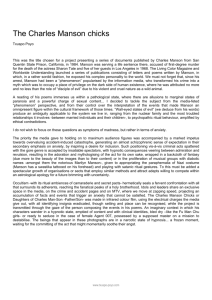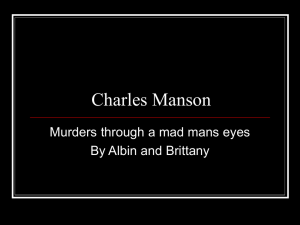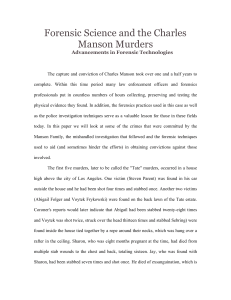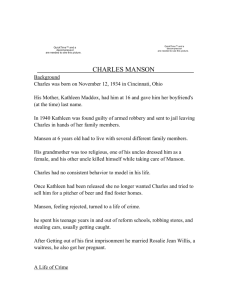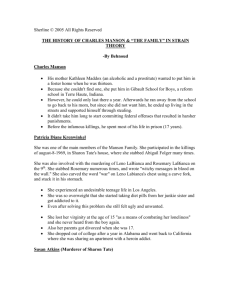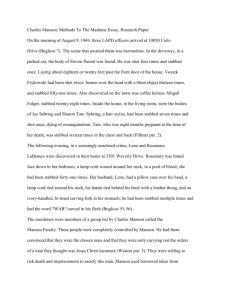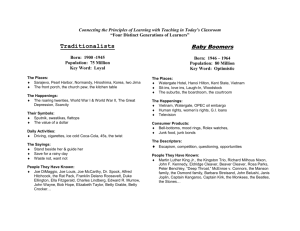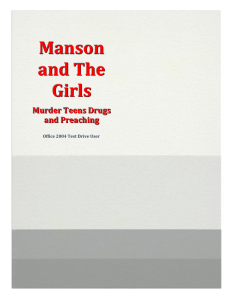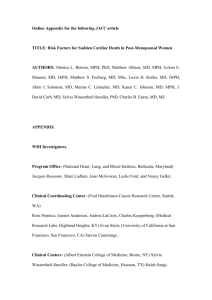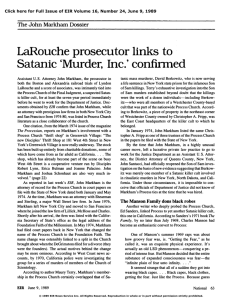manson4
advertisement
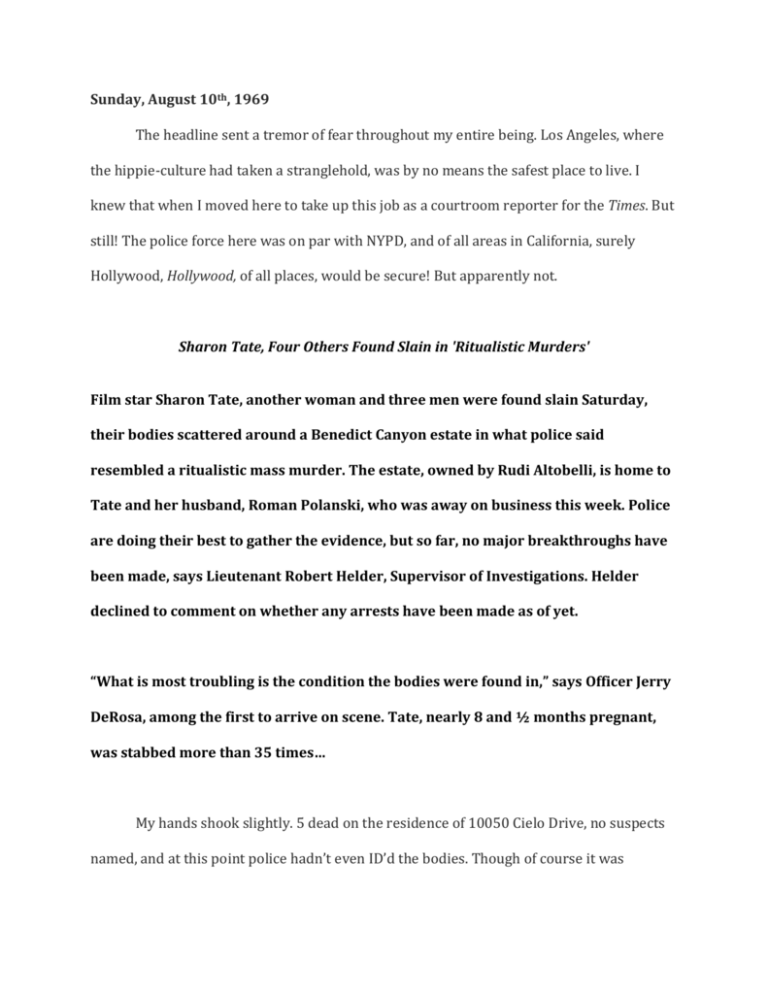
Sunday, August 10th, 1969 The headline sent a tremor of fear throughout my entire being. Los Angeles, where the hippie-culture had taken a stranglehold, was by no means the safest place to live. I knew that when I moved here to take up this job as a courtroom reporter for the Times. But still! The police force here was on par with NYPD, and of all areas in California, surely Hollywood, Hollywood, of all places, would be secure! But apparently not. Sharon Tate, Four Others Found Slain in 'Ritualistic Murders' Film star Sharon Tate, another woman and three men were found slain Saturday, their bodies scattered around a Benedict Canyon estate in what police said resembled a ritualistic mass murder. The estate, owned by Rudi Altobelli, is home to Tate and her husband, Roman Polanski, who was away on business this week. Police are doing their best to gather the evidence, but so far, no major breakthroughs have been made, says Lieutenant Robert Helder, Supervisor of Investigations. Helder declined to comment on whether any arrests have been made as of yet. “What is most troubling is the condition the bodies were found in,” says Officer Jerry DeRosa, among the first to arrive on scene. Tate, nearly 8 and ½ months pregnant, was stabbed more than 35 times… My hands shook slightly. 5 dead on the residence of 10050 Cielo Drive, no suspects named, and at this point police hadn’t even ID’d the bodies. Though of course it was irrational, I looked fugitively over my shoulder at my kitchen window. All was at peace, the sky blue; another sunny day in paradise. But I couldn’t get my hands to stop shaking. Wednesday, November 19, 1969 The amount of work to be done at the Times was astonishing, but exhilarating. I couldn’t help feel that I was part of whirlwind of stories sweeping around me. There was so much news, everywhere, all the time, and so much to write about. And I loved it! It was such a change to love one’s job, I thought to myself as I finished the last two sentence of an article detailing a recent robbery case. I leaned back and kicked my feet up on the desk just as John Kendall walked by. A senior crime reporter, he had been following the Tate murders. A dark cloud seemed to hang over his head, but he stopped as he neared my cubicle. “You look awful,” I laughed to him. “Gee, thanks,” he grimaced at me. “This Tate case is killing me. Heidi’s on me to keep up with it, but nothing’s happening!” “What, is LAPD not cooperating?” I questioned, concerned. “Nah, nah they’re all good guys,” he replied, “But there’s just not much going on in the investigation, ya know. No new leads. No new info.” LAPD, he told me, had been able to ID all the bodies with the help of the neighbors and then when Roman Polanski, Tate’s husband, rushed home from Italy. To no one’s surprise, Polanski had declined to comment for Kendall’s articles. “Poor guy,” John had commented at the time. Two of the Polanski’s best friends, Abigail Folger and Voytek Frykowski, had moved in while Roman was in Italy; one of Sharon’s best friends, Jay Sebring, had also been visiting. All had been murdered, and brutally. The police had found Tate, young, blonde and very pregnant, lying on her side behind the living room couch, drenched in her own blood, and with a rope looped loosely around her neck. The same rope had been thrown over a rafter beam and tied to Sebring. Face covered in a bloody towel, his hands were still up by his face as if to ward off the oncoming blows, skull smashed in by a gun grip. Voytek Frykowski had been found strewn on the lawn, so bloody the reporting officer had thought he was dipped in red paint. He had been shot twice, hit over the head 13 times with a blunt object, and stabbed fifty-one times. Five feet beyond, Abigail Folger was laying in what had been a white nightgown, now red from the stab wounds. And then also 19-year-old Steven Parent, who had been visiting the estate’s young caretaker, had been shot in his car, and arms gashed with knife wounds. Apparently, he had been just about to leave, his car pulling out of the driveway, when Manson’s crew pulled up. An innocent bystander. His parents were inconsolable. “Personally, I just think LAPD screwed up big time with the evidence,” John said to me, dropping to a whisper and checking over his right shoulder. “I mean, they’re under a ton of pressure to wrap up this case because it’s taken them so long. Like seriously. Three months later now? And they just connected the two murders and started working on suspects?” The death trail hadn’t ended with the Tate murders. Supermarket owner Leo LaBianca and his wife Rosemary had been found the following night, both stabbed brutally in their home with a chrome-plated bayonette. The weapon choice was more than disturbing; it showed the killer’s fondness of pretentiousness. They were putting on a show. Perhaps more grotesque than the bodies were the words. Printed on the walls of both homes, and on the doors in Sharon Tate’s residence, were the strangest things. “Pigs” was found written in Sharon’s blood; “Death to political piggies” was everywhere, as was “Helter-skelter” usually misspelled. Somehow, the police hadn’t connected the two murders, just 24 hours apart and with the same words printed, for some weeks. “You know what else I found?” John asked me. “No, what?” I asked, not sure if I wanted to hear. “The stupidest thing. And of course I can’t put in in the articles, but so stupid. Footprints. That officer DeRosa got footprints all over the porch even before the Lieutenants got there, because he stepped in blood and smeared it everywhere. And then he punched the button on the electric gate. Idiot superimposed a fingerprint of one of the killers.” He chuckled darkly. “Wow,” I laughed back. “Some police work.” “Yeah, so now they’re getting kicked by the COP.” “No wonder. Hey, how’s the prosecution coming though?” He checked over his shoulder again. “’k, you didn’t hear this from me, got it? But the DA’s head of Trials Division is representing the People. Aaron Stovitz. Him and that other guy that’s been doing really well… what’s his name?” “Not Vince Bugliosi?” I asked. Bugliosi had been scoring majorly; only 35, he had been in 104 prosecutions, and gotten charges filed in all but 2. “Yeah, yeah! Him. Should be one hell of a case. They just announced it this morning, but apparently Bugliosi doesn’t think they have enough to prosecute yet. Take care, Stephan,” he said, patting my cubicle frame as he walked away. Enough to prosecute? I wondered to myself. The public wasn’t aware that the investigations had led to any suspects, or that the investigation was going anywhere at all, for that matter. What did Kendall know? I drifted deep into thought. Tuesday, November 26, 1969 I had the TV in my kitchen turned up almost to full volume, waiting for baseball’s Rookie of the Year to be announced, as I pawed through my refrigerator looking for bell peppers. Muttering under my breath, I finally found one. Red. As I set to work slicing it to put in with my stir-fry, the newscasters finally announced it: Outfielder Lou Piniella, with his fairly solid .282 batting average. “Yes!” I shouted, pumping the air with the knife still in my hand—not a smart move. In my excitement, I cut the side of my finger. Swearing under my breath, I rinsed my finger under the tap. If I hadn’t cut myself, though, I probably would have turned off the TV. I never would have heard what George Putnam had to say. But I did, staring sulkily at the news while nursing my finger. “Breakthroughs have been made on the Sharon Tate murders, this week,” he announced. “And on Wednesday, folks, we will have the name of the killer.” It was a good thing I had already put the knife down. My phone was already ringing. First Heidi, then John. “Stephan!” she shouted into my ear. “Get in touch with John right now. If this thing is going to court, you’re going to partner with him on it. I was a front page with whatever it is these reporters know that we don’t. Get on it!” Just as I was dialing John, he called me. “Go for Stephan,” I always answered. You talked to Heidi yet?” “Yeah, of course. Just hung up.” “You’d better set your alarm for early, then. Be in the office by 5:30, 6 at the latest. It sounds like they’re getting ready for a trial, and that’s going to be your area. I need to fill you in.” “Yeah, yeah, absolutely,” I answered, dumbstruck. “I’ve got to start making calls though. See you in the morning.” And then he hung up. But by the time I got to the office, 5:30 sharp, things had already changed again. Bugliosi’s office had called John that same night, had called all the major reporters following the case, for that matter, and Heidi was not happy. The DA had demanded a freeze on all information on the case. Apparently, the investigation was at such a critical stage that there needed to be a complete media blackout. John stumbled in, glasses crooked, papers falling out of his briefcase. Throwing his things down on his desk, he looked around wildly for me. Target acquired, he motioned me over to Heidi’s office. She was thoroughly upset by this time, pacing her office as we walked in. John didn’t even give her a chance to start. “Charles Manson,” he breathed. I was dumbstruck. I had been doing some reporting on Manson; currently, he was being held at Sybil Brand on auto theft charges. Police had raided the Death Valley ranch he had been living on four times already, and rounded up almost 35 members of a hippie group that called themselves the “family.” I wasn’t sure how many of them remained in custody. Stolen rental cars, dune buggies, an unbelievable amount of drugs and piles of clothes were found all over the property. “The hippie cult leader?” I squawked. “Yeah,” he replied, slightly out of breath. “I just talked to Bugliosi’s office. They think they’re close to connecting him, but they need a freeze.” “They have until Monday,” allowed Heidi testily. “This is too big to keep quiet for long.” Apparently, the DA had been able to get a $25,000 bail on Manson, and a considerable sentence despite the minor charges in order to hold him until they could pin the murders. 18 points on a latent print from the Tate residence had been matched to Charles “Tex” Watson, Manson’s right-hand man. And so far, as many as 5 of the girls had suspected involvement; so far, Susan Atkins, Leslie Van Houten, and a young woman by the name of Linda Kasabian. Wednesday, March 3rd, 1970 In the weeks following the realization that Charles Manson and a few members of his twisted “family” were the killers, LAPD, LASO and the prosecution team continued to spend almost 100 hours a week compiling evidence to pinpoint the actual killers. It had soon become evident that it would still take months for the case to ever see the inside of a courtroom. And so, despite Heidi’s declaration that I was to partner articles on the murders, the entire story lay outside my domain of court reporting. Charlie Manson remained well off my priority list. Or so I thought, until John walked by my desk on his way out of the office at the strange hour of 11 am. He gave me a half-hearted smile, but looked pale. “Hey, you skipping out already?” I asked jokingly. He motioned a finger to his lips, shushing me. “Hey, hey quiet there,” he laughed, looking more like himself. His eyes suddenly grew serious, though. “I finally got a major breakthrough today,” he said quietly. “Guess where Bugliosi is right now?” I hesitated to think. “Sybil Brand!” he exclaimed. Oh Jesus, I thought. Surely he hadn’t been arrested. Seeing my expression, John chuckled again. “No, no, could you imagine the head prosecutor locked up? He’s interviewing Linda Kasabian. Apparently they’re granting her immunity for the entire story, and she’s giving it to them! He’s already been down there for three hours. Supposedly they’re taking her out today, too. And I will be waiting outside those doors to get a statement,” he bragged lightly. He looked around before dropping his voice even more quietly. “They say she wasn’t directly involved, that she didn’t actually kill anyone, but that she was driving the car or something. So she knows everything. Is gonna name all the suspects. Stephan, this thing is actually gonna go to court!” his excitement was apparent even despite his haggard look. Something rushed down my spine. Maybe I would get a piece of this story after all. Sooner than I thought, in fact. Manson appeared in court three days later. Friday, March 6, 1970 I sat in the tiny courtroom near the front, in the press section, leaning on the edge of my seat to wait for the case to start. All around me were the photographers, journalists, TV crews waiting for his grand entrance. On charges of auto theft, Charlie was finally appearing in court. And better yet, he was representing himself. It should be an interesting trial, I mused to myself. But I couldn’t help admitting I was both terrified and perhaps strangely excited to see this man who had been commanding so much attention as of late. I was shocked when he was led in, wrists handcuffed to his waist and escorted by two deputies—he was tiny, not even over 5’2”. But somehow, he walked with a swagger that spoke of comfort. He was completely at ease with the situation. His dark, bushy hair was long, almost to his shoulders, and his beard was equally as impressive. But worst of all were his eyes; dark, tiny, they were strangely captivating. There was no guilt, no remorse, no admission inside of them. Nothing even hinted he had a conscience. Maybe he didn’t realize it, I thought to myself. Perhaps this man truly thought he was right, justified in his ends. Monday, August 3rd, 1970 How was he still alive? Vince Bugliosi paced agitatedly before pausing, one arm folded across his chest and the other hand on chin, elbow resting on his other arm, clearly agitated. It burned me that the overseeing judge, Charles Older had issued the gag order. Attorneys were to stop giving interviews, because even a passing phrase from this man surely would have made the front page of any national paper at this point. Or better yet, a member of the jury, but of course that was impossible in any trial, let alone this most famous Manson prosecution. But what I wouldn’t give to get inside their heads! From John Baer, the electric technician, who always sat so silently, staring so intently at whomever was speaking. Or even highway engineer William Zamora, who always stared at the clock. How was this even possible? With a possible death penalty available for five different defendants, how was he not riveted? I suppose I could sympathize slightly, though. The entire panel of 12 jurors, plus their 6 alternates, had been selected back in June. And since then, they had all been sequestered in a nearby hotel, and shuttled to the courtroom in a bus with its windows painted black. This was both for their own protection and also to prevent the media from contaminating their opinions. It was the 10th day of the trial, and the prosecution had called 8 of their witnesses. The first seven so far mainly were mainly to testify to the identity of the victims, but the eighth? The 8th was Linda Kasabian. Bugliosi had already spent three days on direct examination, and today marked the 5th day of cross. And slowly, in the last 7 days, had the whole horrific story been told to the jury; how Charlie had told Linda to grab her driver’s license and gathered two of the other girls, Susan “Sadie” Atkins, and Patricia “Katie” Krenwinkel. How he had told them to go the Cielo drive residence and do whatever Tex said. How they had driven up, how Tex had shimmied up the telephone pole and cut the wires, then seeing Steve Parent drive up, how he had been slashed and then shot. How the girls had swept, barefoot, across the lawn and slit open a screen door, and then set out stabbing and bludgeoning the residents as Linda had stood outside, keeping watch. As they were leaving, how Tex called, “wait. Leave something. You girls know what to do, write something witchy.” A bead of sweat rolled down my temple as I sat on the edge of my seat. Irving Kanarek was doing his cross examination. Long ago had I abandoned directly quoting Manson’s own lawyer; the vast majority of his verbal additions to the trial were objections, anyways. After reaching 200 within the first two days, I stopped counting. Additionally, his approach when questioning was often difficult to determine. On multiple occasions I had listened on, frustrated, as he asked for his questions to be read back to him because they were so rambling and poorly thought out that he had lost his own train of thought. I remembered fondly to myself conversations with my now elderly father, a forward man and once, like Bugliosi, a criminal prosecutor. “A good lawyer never asks a question in court when he doesn’t already know the answer,” he had once told me of his profession. But Kanarek seemed to always try to do the opposite, either asking questions he clearly wasn’t prepared for, or trying to undermine the prosecution in ways that always seemed to backfire on him. He rambled on incessantly, even hypocritically, never seeming to have a clear goal in mind. He looked tired as well, but in reality, they all did-- Kanarek, Fitzgerald, Hughes, Shinn, Bugliosi, Steven Kay and Donald Musich, Bugliosi’s young team; the jury and alternates; Olden, especially worn from having to deal with Kanarek; even John Kendall, sitting beside me. It seemed like the 10 days in this courtroom had already been an eternity, and it was nothing compared to what was to come. Olden had predicted 3 months for the original sequestration period for the jury. I don’t know if anyone realized that this would continue on for not a week, like most criminal trials, not even a few weeks like most murder trials, but almost exactly 8 months. And here we all were, exhausted, with Linda Kasabian still on the stand. I wasn’t entirely sure what Daye Shinn, Leslie Van Houten’s defense attorney, was doing at the present moment, but his cross-examination didn’t seem to be going well. As I looked up to watch him nervously pacing back and forth, he stopped and looked up at Linda. “Was it your impression that other people at the ranch loved Charlie?” he asked. “Oh yes. It seemed the girls worshipped him, would die to do anything for him,” she replied earnestly. Bugliosi’s strategy was fairly clear. Through Linda’s testimony detailing the events leading up to the murders, and then her own description of the night’s events, and the before that, through the previous witnesses and his opening statements, Vince was trying to show the magnetic attraction of Manson and his little “family”. To show the cult worship they all had for him, his power over them. And Shinn had just reinforced this. Manson sat not even 20 feet away from me at the present moment. It fascinated me that such a physically small person could have such a draw on the people around him— something I had realized back in March, when I saw him for the first time. His physical pull was not in his stature, but rather in his face. In his eyes. I will never forget the eyes of Charles Manson. He had this strange way of picking people to stare at. Usually, judge Olden, just as he was doing now, as Linda spoke from the stand about this very same pull. His eyes, small and dark, even black, were sickly fascinating. The complete lack of expression… I shuddered, and another bead of sweat ran down my forehead. I wiped it away with my shirtsleeve, deliberately pulling the soft cloth out of my jacket pocket to clean my glasses. My breath now came rapidly, coming in spurts as it did when I thought too hard about Manson. So I stared very, very deliberately at my glasses as I wiped tiny circles with my thumb in the cloth across the lenses. Left first, then right, until the moment had passed and I could breathe again. Thirty minutes until court adjourned for the day, and Linda was still on the stand, Manson was still staring at Olden and Shinn was still pacing back and forth and he contemplated his next move. They were still on the general topic of Manson’s influence on the Family but Shinn had shifted tactics. Instead, he focused on the fear he instilled in the members, and thus indirectly, his own client. I recognized the subtle difference; he could later insinuate that his client had been coerced by Manson if Linda now testified to the general fear he instilled in people. Having just gotten to her to admit to her fear, he followed, “What were you afraid of?” “I was just afraid… he was a heavy dude,” Linda looked a bit unfocused, trying to find the right phrase to answer. “He just had something, you know, that could hold you. He was a heavyweight. He was just heavy, period.” I thought bizarrely of a planet, or the sun, a massive object with the gravity and weight to pull objects into orbit. Charlie Manson was the center of some twisted universe. And with that, court adjourned for the day. In a strange sort of daze, I gathered my notes into my briefcase, smiled vacantly at John, and continued to ponder the ability of one small man to create this whole word. As I grabbed my jacket and walked out the front door, down the steps to the main lobby, and onto the street, it took me all of 14 minutes to be reminded of Manson’s magnitude again. August 3rd, as it turned out, was the same day that President Nixon had issued a statement. My pager buzzed in my pants pocket. Heidi. Apparently, Nixon had been complaining about the celebrity status the press created for criminals. In doing so, he had mentioned that he had noted “the coverage of the Charles Manson case… Here is a man who is guilty, directly or indirectly, of eight murders. Yet here is a man who, as far as the coverage is concerned, appears to be a glamorous figure.” The alarm bells immediately started ringing in my head as I heard of the AP wire. What a story! Suddenly I was rushing back into the court room, at the end of another day of normal testimony, needing more than ever a comment from Vince Bugliosi, or even from the defense. From Kanarek, from Fitzgerald, anyone! The president had just declared Manson guilty. August 4th, 1970 The day was dull, and it was hot in the courtroom. I mused how much I disliked my job. Just a few minutes before lunch, I glanced over at the defense, and realized something was off. Not half a second later, Manson had jumped over the defense table and was holding the front page of the Times to reveal the headline: Manson Guilty, Nixon Declares A bailiff tackled him, but the damage had been done. Surely, Kanarek would move for a mistrial. Older ordered the jury removed. And suddenly, a sleepy courtroom was filled with quiet tension. Left standing, dumbstruck once again, I realized I should begin packing. Each of the jurors would be individually interviewed by the Judge to determine if they had been influenced by the headline, and if they had been, the last several weeks would have been a waste. I headed for home. September 28th, 1970 As it turned out, the jurors had all thought the president’s remarks foolish and unfounded, as they themselves were the only ones who had heard all of the evidence and testimony thus far. Kanarek still moved for a mistrial. Motion denied. And so the trial continued on, no end in sight. Bugliosi called Juan Flynn, a ranch hand at Spahn Ranch where the family had been hiding out. The gangly Panamanian cowboy seemed unassuming, but carried a quiet confidence. I watched as Manson set his eerie glare on him, but all he did was glare back. I was impressed, knowing I would surely quake under that stare. Bugliosi had brought him up to ID the .22 caliber revolver found at the Tate scene; shown a picture, he did, going on to say it was Manson’s personal weapon of choice. I tried to stifle a yawn. Though this was important testimony, by back was stiff from the courtroom benches. I looked around at the dingy walls that I had memorized, and remembered angrily wondering how the jurors could have looked so disinterested when Linda had been testifying. But now I understood, some 10 weeks later, after sitting through so many hours of this case while also reporting on so many others. “And so I asked her, ‘Where y’all goin’?’” I was snapped back into the moment as I realized what Juan was saying. “And she replied, ‘we’re gonna go get us some f** pigs!’” I grabbed for my notepad to write this down. He was talking about speaking with Sadie Atkins the night the LaBiancas were killed, before Manson, Linda, Sadie, Katie and Leslie had set out that night. “And did you speak to Charlie in the next few days?” Bugliosi asked. I don’t even know if Vince himself had expected Juan’s answer. “Well, yeah. I mean, a few days later, he pulls a knife on me! In the kitchen, I mean. He holds me against the wall, all menacing, and I say something casual, ya know, tryin’ to be funny, and he hold up this knife to my throat! And he says to me, real quiet-like, ‘you son of a bitch. Don’t you know it’s me doin’ all these killings?!’” I don’t think I ever packed so fast. Sprinting for the door, I got the first taxi back to the office, and started typing furiously. Manson Admitted Murders, Spahn Ranch Cowboy Says Monday, November 19th, 1970 Dr. Deering, who testified to the competence of Linda Kasabian’s metal health, was called and heard. And then finally, at 4:27, Bugliosi finally stood, slowly and with weight. “You honor,” he called, “the People of the State of California rest.” A collective sigh went out. The defense made the standard motions for dismissal; denied, of course. The end was finally in sight, with the guilt phase of the trial exactly halfway through. The defense was next to call witnesses. So Judge Older then called to Fitzgerald, “Are you ready to proceed with the defense?” to which he answered, “Yes.” “You may call your first witness, Mister Fitzgerald.” But he didn’t. “The defense rests, your honor,” he simply said. One would have thought a riot broke out. Manson and the girls all shouted plaintively, and I glanced at Bugliosi, then Older. Both had their mouths open so wide that flies could have flown in. With the girls still shouting that they wanted to testify, Older ordered the attorneys into chambers. As I later heard, the defense attorneys had been trying to protect their individual clients. The girls had all planned to testify they had been acting on their own accord, thus acquitting Charlie. Fitzgerald had instead taken the chance away from them, diffusing Charlie’s bombshell. Of course, the legal problems created were immense. Older paced his chambers, debating two key constitutional rights: the right to testify versus the right to effective counsel. Eventually, it was decided that Manson could testify, but only outside the presence of the jury. The girls were given the opportunity, but it was then revoked under the context of a previous Supreme Court case, The People v. Aranda. Testimony given by a defendant implicating their co-defendants must be struck, and the girls simply would not cooperate. I would have bent over backwards to hear Manson’s testimony, but Older simply would not allow anyone in the courtroom. The crowd of press waited eagerly outside instead. And as rumor had it, it was the performance of a lifetime. I read the transcripts later, read his every word, imaging his eerie blank stare fixed on Bugliosi as he spoke. “My father is the jailhouse. My father is your system… I am only what you made me. I am only a reflection of you…” and then rose to near screaming, “You expect to break me? Impossible! You broke me years ago. You killed me years ago!” I can see his eyes, those immortal eyes, even when I try to black him out. Monday, December 21st, 1970 End in Sight on Manson Trial Head Prosecutor Vince Bugliosi will give his opening arguments this week, courtroom officials say. This is to be followed by the defense’s arguments, and then finally by the closing arguments by the prosecution. Both sides decline comment on the predicted outcome of the trial… January 15th, 1971 Manson Trial Concludes with ‘Roll Call of the Dead’ Returned from a court-ordered recess, Attorney Vince Bugliosi gave the final closing arguments today in the Manson case. Speaking passionately about Manson’s character and alleged crimes, Bugliosi said: “What resulted [of Manson] was perhaps the most inhuman, night-marish, horrorfilled hour of savage murder… in the recorded anals of crime.” Bugliosi went on to reiterate the events of the nights of august 9th and 10th, and finally ending by naming off each of the victims, with pause and weight… January 25th, 1971 I walked into the courtroom for the final time that morning, and sat down not fully knowing what to expect. After sitting through the majority of the some 8-month trial, writing more articles than I could possibly count, I sat down and realized I felt old. My bones ached. My scalp itched. My eyes watered behind my glasses. The scene was set just as it had been of every day for the court proceedings. Bugliosi, Kay and Musich sat behind the prosecution’s table; Fitzgerald, Kanarek, Shinn and Hughes sat with the defendants. Leslie Van Houten, charged with the LaBianca murders, Susan Atkins and Patricia Krenwinkel charged with both the LaBianca and Tate murders. And of course, those black, guilt-less eyes. Charles Manson. Judge Older sat behind the bench. And then quietly, somberly, in walked the jury. A plain white paper was handed to the clerk, and he began to read. “In the superior Court of the state of California, in and for the county of Los Angeles, the People of The State vs. Charles Manson, Patricia Krenwinkel, Susan Atkins, and Leslie Van Houten, case number A-253, 156. Department 104.” Everyone sat as if frozen. The court had never been this silent. “We, the jury in the above-entitled action, find the defendant, Charles Manson, guilty of the crime of murder of Abigail Folger in the first degree, in violation of section 187…” He droned on for nearly an hour, with 27 separate verdicts to be read. But on every single last count, Bugliosi had succeeded. All four defendants were charged with first-degree murder. And all four were later given the death penalty. Charlie Manson gave no perceptible change with his face, but instead moved his head around the courtroom. When he stopped, he was staring directly into my face.
